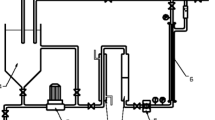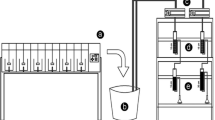Abstract
Reverse osmosis concentrate (ROC) from municipal wastewater reclamation reverse osmosis (mWRRO) contains elevated concentrations of contaminants which pose potential risks to aquatic environment. The treatment of ROC from an mWRRO using granular activated carbon (GAC) combined pretreatment of coagulation was optimized and evaluated. Among the three coagulants tested, ferric chloride (FeCl3) presented relatively higher DOC removal efficiency than polyaluminium chloride and lime at the same dosage and coagulation conditions. The removal efficiency of DOC, genotoxicity, and antiestrogenic activity concentration of the ROC could achieve 16.9, 18.9, and 39.7 %, respectively, by FeCl3 coagulation (with FeCl3 dosage of 180.22 mg/L), which can hardly reduce UV254 and genotoxicity normalized by DOC of the DOM with MW <5 kDa. However, the post-GAC adsorption column (with filtration velocity of 5.7 m/h, breakthrough point adsorption capacity of 0.22 mg DOC/g GAC) exhibited excellent removal efficiency on the dominant DOM fraction of MW <5 kDa in the ROC. The removal efficiency of DOC, UV254, and TDS in the ROC was up to 91.8, 96, and 76.5 %, respectively, by the FeCl3 coagulation and post-GAC adsorption. Also, the DOM with both genotoxicity and antiestrogenic activity were completely eliminated by the GAC adsorption. The results suggest that GAC adsorption combined pretreatment of FeCl3 coagulation as an efficient method to control organics, genotoxicity, and antiestrogenic activity in the ROC from mWRRO system.







Similar content being viewed by others
References
Agus E, Sedlak DL (2010) Formation and fate of chlorination by-products in reverse osmosis desalination systems. Water Res 44:1616–1626
Al-Rifai JH, Khabbaz H, Schaefer AI (2011) Removal of pharmaceuticals and endocrine disrupting compounds in a water recycling process using reverse osmosis systems. Sep Purif Technol 77:60–67
Bagastyo AY, Keller J, Batstone DJ (2011a) Size fractionation characterisation of removed organics in reverse osmosis concentrates by ferric chloride. Water Sci Technol 63:1795–1800
Bagastyo AY, Keller J, Poussade Y, Batstone DJ (2011b) Characterisation and removal of recalcitrants in reverse osmosis concentrates from water reclamation plants. Water Res 45:2415–2427
Chen W, Westerhoff P, Leenheer J, Booksh K (2003) Fluorescence excitation—emission matrix regional integration to quantify spectra for dissolved organic matter. Environ Sci Technol 37:5701–5710
Comerton AM, Andrews RC, Bagley DM (2005) Evaluation of an MBR-RO system to produce high quality reuse water: microbial control, DBP formation and nitrate. Water Res 39:3982–3990
Comstock SEH, Boyer TH, Graf KC (2011) Treatment of nanofiltration and reverse osmosis concentrates: comparison of precipitative softening, coagulation, and anion exchange. Water Res 45:4855–4865
Dialynas E, Diamadopoulos E (2009) Integration of a membrane bioreactor coupled with reverse osmosis for advanced treatment of municipal wastewater. Desalination 238:302–311
Dialynas E, Mantzavinos D, Diamadopoulos E (2008) Advanced treatment of the reverse osmosis concentrate produced during reclamation of municipal wastewater. Water Res 42:4603–4608
Duan JM, Gregory J (2003) Coagulation by hydrolysing metal salts. Adv Colloid Interface Sci 100:475–502
Edzwald JK (1993) Coagulation in drinking-water treatment—particles, organics and coagulants. Water Sci Technol 27:21–35
GB 5749 (2006) Chinese Standards for drinking water quality. Standardization Administration of the People’s Republic of China, Beijing
Gibert O, Lefevre B, Fernandez M, Bernat X, Paraira M, Pons M (2013) Fractionation and removal of dissolved organic carbon in a full-scale granular activated carbon filter used for drinking water production. Water Res 47:2821–2829
Haberkamp J, Ruhl AS, Ernst M, Jekel M (2007) Impact of coagulation and adsorption on DOC fractions of secondary effluent and resulting fouling behaviour in ultrafiltration. Water Res 41:3794–3802
Ho JS, Ma Z, Qin J, Sim SH, Toh C (2015) In line coagulation-ultrafiltration as the pretreatment for reverse osmosis brine treatment and recovery. Desalination 365:242–249
Hsu S, Singer PC (2009) Application of anion exchange to control NOM interference on lime softening. J Am Water Works Assoc 101:85–94
ISO 13829 (2000) Water quality—determination of the genotoxicity of water and wastewater using the umu-test, 1st edn. International Standard Organisation, Geneva
Jacob M, Guigui C, Cabassud C, Darras H, Lavison G, Moulin L (2010) Performances of RO and NF processes for wastewater reuse: tertiary treatment after a conventional activated sludge or a membrane bioreactor. Desalination 250:833–839
Justo A, Gonzalez O, Acena J, Perez S, Barcelo D, Sans C, Esplugas S (2013) Pharmaceuticals and organic pollution mitigation in reclamation osmosis brines by UV/H2O2 and ozone. J Hazard Mater 263:268–274
Knappe DRU, Snoeyink VL, Dagois G, Dewolfe JR (1992) Effect of calcium on thermal regeneration of GAC. Am Water Works Assoc J 84:73–80
Linge KL, Blythe JW, Busetti F, Blair P, Rodriguez C, Heitz A (2013) Formation of halogenated disinfection by-products during microfiltration and reverse osmosis treatment: Implications for water recycling. Sep Purif Technol 104:221–228
Matilainen A, Vepsalainen M, Sillanpaa M (2010) Natural organic matter removal by coagulation during drinking water treatment: a review. Adv Colloid Interface Sci 159:189–197
Mitch WA, Sedlak DL (2004) Characterization and fate of N-nitrosodimethylamine precursors in municipal wastewater treatment plants. Environ Sci Technol 38:1445–1454
Nguyen LN, Hai FI, Kang J, Price WE, Nghiem LD (2013) Coupling granular activated carbon adsorption with membrane bioreactor treatment for trace organic contaminant removal: breakthrough behaviour of persistent and hydrophilic compounds. J Environ Manag 119:173–181
Perez-Gonzalez A, Urtiaga AM, Ibanez R, Ortiz I (2012) State of the art and review on the treatment technologies of water reverse osmosis concentrates. Water Res 46:267–283
Pramanik BK, Roddick FA, Fan L (2015) A comparative study of biological activated carbon, granular activated carbon and coagulation feed pre-treatment for improving microfiltration performance in wastewater reclamation. J Membr Sci 475:147–155
Rolence C, Machunda RL, Njau KN (2014) Water hardness removal by coconut shell activated carbon. Int J Sci, Technol Soc 2:97–102
Russell CG, Lawler DF, Speitel GE Jr (2009) NOM coprecipitation with solids formed during softening. J Am Water Works Assoc 101:112–124
Stalter D, Magdeburg A, Oehlmann J (2010) Comparative toxicity assessment of ozone and activated carbon treated sewage effluents using an in vivo test battery. Water Res 44:2610–2620
Sun YX, Gao Y, Hu HY, Tang F, Yang Z (2014) Characterization and biotoxicity assessment of dissolved organic matter in RO concentrate from a municipal wastewater reclamation reverse osmosis system. Chemosphere 117:545–551
Sun YX, Hu HY, Shi CZ, Yang Z, Tang F (2016) Changes in the components and biotoxicity of dissolved organic matter in a municipal wastewater reclamation reverse osmosis system. Environ Technol Published online Feb 19. 1–8
Tang F, Hu H, Wu Q, Tang X, Sun Y, Shi X, Huang J (2013a) Effects of chemical agent injections on genotoxicity of wastewater in a microfiltration-reverse osmosis membrane process for wastewater reuse. J Hazard Mater 260:231–237
Tang X, Wu Q, Huang H, Hu H, Li Q (2013b) Removal potential of anti-estrogenic activity in secondary effluents by coagulation. Chemosphere 93:2562–2567
Umar M, Roddick F, Fan L (2015) Recent Advancements in the Treatment of Municipal Wastewater Reverse Osmosis Concentrate-An Overview. Crit Rev Environ Sci Technol 45:193–248
Uyak V, Yavuz S, Toroz I, Ozaydin S, Genceli EA (2007) Disinfection by-products precursors removal by enhanced coagulation and PAC adsorption. Desalination 216:334–344
Velten S, Knappe DRU, Traber J, Kaiser H, von Gunten U, Boller M, Meylan S (2011) Characterization of natural organic matter adsorption in granular activated carbon adsorbers. Water Res 45:3951–3959
Wert EC, Gonzales S, Dong MM, Rosario-Ortiz FL (2011) Evaluation of enhanced coagulation pretreatment to improve ozone oxidation efficiency in wastewater. Water Res 45:5191–5199
Wu Q, Hu H, Zhao X, Sun Y (2009) Effect of Chlorination on the Estrogenic/Antiestrogenic Activities of Biologically Treated Wastewater. Environ Sci Technol 43:4940–4945
Wu Q, Hu H, Zhao X, Li Y (2010a) Effects of chlorination on the properties of dissolved organic matter and its genotoxicity in secondary sewage effluent under two different ammonium concentrations. Chemosphere 80:941–946
Wu Q, Hu H, Zhao X, Li Y, Liu Y (2010b) Characterization and identification of antiestrogenic products of phenylalanine chlorination. Water Res 44:3625–3634
Zhou T, Lim T, Chin S, Fane AG (2011) Treatment of organics in reverse osmosis concentrate from a municipal wastewater reclamation plant: Feasibility test of advanced oxidation processes with/without pretreatment. Chem Eng J 166:932–939
Acknowledgments
We would like to thank Dr. Danmeng Shuai (GWU) for the review and discussion. This study was funded by the National Nature Science Foundation of China (No. 21306003) and Beijing Natural Science Foundation (No. 8142010) and China Scholarship Council.
Author information
Authors and Affiliations
Corresponding author
Additional information
Responsible editor: Gerald Thouand
Rights and permissions
About this article
Cite this article
Sun, YX., Yang, Z., Ye, T. et al. Evaluation of the treatment of reverse osmosis concentrates from municipal wastewater reclamation by coagulation and granular activated carbon adsorption. Environ Sci Pollut Res 23, 13543–13553 (2016). https://doi.org/10.1007/s11356-016-6525-4
Received:
Accepted:
Published:
Issue Date:
DOI: https://doi.org/10.1007/s11356-016-6525-4




